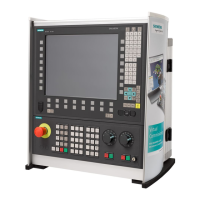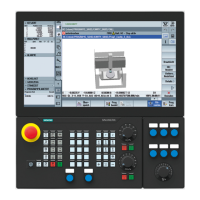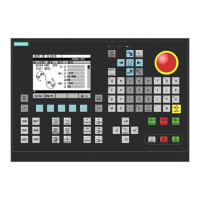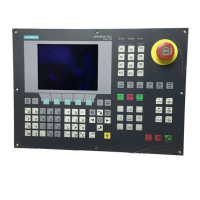Detailed Description
2.12 Block descriptions
PLC Basic Program Solution Line (P3 sl)
2-156 Function Manual, 08/2005 Edition, 6FC5397-0BP10-0BA0
2.12.12 FC 3: GP_PRAL Basic program, interrupt-driven section
Description of functions
Block-synchronized transfers from the NCK to the PLC (auxiliary and G functions) are
carried out in the interrupt-driven part of the basic program. Auxiliary functions are
subdivided into normal and high-speed auxiliary functions. The high-speed functions of an
NC block are buffered and the transfer acknowledged to the NC. These are passed to the
application interface at the start of the next OB1 cycle. Normal auxiliary functions are only
acknowledged when they have existed for the duration of one cycle. This allows the
application to issue a read disable to the NC.
High-speed auxiliary functions programmed immediately one after the other, are not lost for
the user program. This is ensured by a mechanism in the basic program.
The G functions are evaluated immediately and passed to the application interface.
NC process interrupts
If the interrupt is triggered by the NC (possible in each IPO cycle), a bit in the local data of
OB 40 ("GP_IRFromNCK") is set by the basic program. (only if FB 1 parameter UserIR :=
TRUE). This data is not set on other events (process interrupts through I/Os). This
information makes it possible to branch into the associated interrupt routine in the user
program in order to initiate the necessary action. To be able to implement high-speed, job-
driven processing of the user program for the machine, the following NC functions are
available in the interrupt processing routine (OB 40 program section) for the PLC user
program:
• Selected auxiliary functions
• Tool-change function for tool-management option
• Position reached for positioning axes, indexing axes and spindles with activation via PLC
The functions listed above can or must be evaluated by the user program in OB 40 in order
to initiate reactions on the machine. As an example, the revolver switching mechanism can
be activated when a T command is programmed on a turning machine.
For further details on programming hardware interrupts (time delay, interruptibility, etc.) refer
to the corresponding SIMATIC documentation.
Auxiliary functions,
Generally, high-speed or acknowledging auxiliary functions are processed with or without
interrupt control independently of any assignment.
Basic-program parameters in FB 1 can be set to define which auxiliary functions (T, H, DL)
must be processed solely on an interrupt-driven basis by the user program.
Functions which are not assigned via interrupts are only made available by the cyclic basic
program as in earlier versions. The change signals of these functions are available in a PLC
cycle.
Even if the selection for the auxiliary function groups (T, H, DL) is made using interrupt
control, only one interrupt can be processed by the user program for the selected functions.
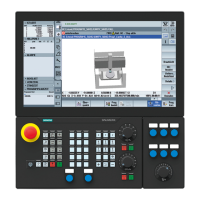
